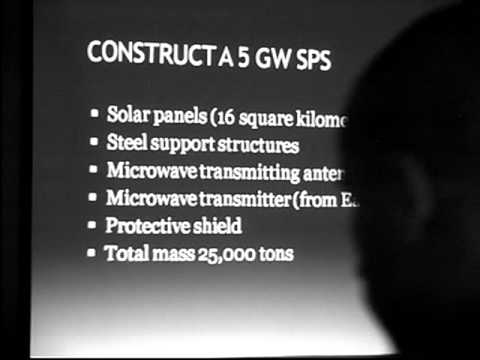Many of science’s biggest ideas start out as fantasies, often considered ludicrous – until they’re achieved. The moon shot would be the most familiar example of something quickly going from risible poppycock to fait accompli. A slightly earlier one would be Leó Szilárd running around showing everyone he could (mostly scoffing skeptics, with some notable exceptions like, say, Albert Einstein) the basic design for an atomic weapon.
Similarly, physicist David Criswell, director of the Institute for Space Systems Operations at the University of Houston, has spent the last four decades evangelizing for a novel energy solution: solar power from the moon. The advantages to such a scheme, if it’s feasible, are immediately obvious:
- The lack of atmosphere, and thus weather, on the moon makes it a much more reliable location for receiving sunlight than any place on Earth.
- The environmental damage caused by energy resource exploitation and the burning of fossil fuels could be halted or slowed on Earth.
- As romantic a symbol as the Moon may be, we’ve discovered that there’s not really much there to be despoiled – no moon people, no wildlife, just a big potholed parking lot in space – so we needn’t feel as guilty as we do on Earth about altering it as we see fit.
The challenges are equally clear:
- How do we pay for it? Budgeting is the great constraint in most of life’s dreams, but especially in the realm of space exploration. This scheme would naturally involve huge upfront expenditures – but if successful, it would not only pay for itself, it would revolutionize the entire economy.
- How do we transport the energy back to Earth? Having to ferry some kind of physical energy storage back and forth would defeat the purpose, and be dangerous and expensive. The focus has been on wireless power transmission via laser or, more likely, microwave beam, down to receptor sites on Earth. This would pose its own safety and environmental concerns, which may be quite doable, but the technology remains largely theoretical.
Similar concepts have been proposed for asteroids and Sun-orbiting satellites, but as a well-known, nearby object with gobs of surface area, the moon seems like the most promising candidate for space-based solar power harvesting. Experiments have already been done to show that rudimentary solar cells can be built using only the materials already extant in the moon’s surface.
Sure, it seems like an idea whose time is still a long way off. That was once true of visiting the moon at all…until it wasn’t. And it happened very fast. Looking back at John Kennedy’s famous “by the end of this decade” ultimatum, doesn’t it seem wildly optimistic, the kind of goal politicians set and then never achieve?
But damn it all, we did it. The next time someone you hear someone complain the government can’t do anything right, remind them of that. It was sad to see that Newt Gingrich was mocked in last year’s GOP primary less for his genuine bad ideas (and they were legion) than for his support of a permanent moon colony. If there was ever a time to think big, this is it.
This guest post has been provided courtesy of Mariana Ashley, an education blogger who offers accredited online colleges news to those investigating their career options. You can contact her at [email protected].
Image credit: kukkurovaca via photo pin cc



Gerry
It’s a pipe dream, unless the solar panels are produced on the Moon.
Tom Murphy did a rough estimate of solar power in earth orbit, well, it doesn’t really make sense:
http://physics.ucsd.edu/do-the-math/2012/03/space-based-solar-power/
solar-tec
Is this really possible? The moon itself is only relying on the sun’s power.
David R. Criswell
The LSP System is built from lunar materials. The sun is the largest power source in the solar system and it is paid for. For a quick look go to these sites:
http://www.spaceref.com/news/viewsr.html?pid=10926
http://www.tipmagazine.com/tip/INPHFA/vol-8/iss-2/p12.pdf